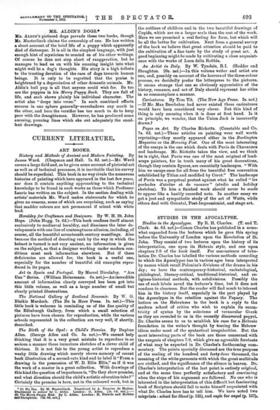STUDIES IN THE APOCALYPSE.
Studies in the Apocalypse. By R. H. Charles. (T. and T. Clark. 4s. fid. net.)—Canon Charles has published in a some- what expanded form the lectures which he gave this spring before the University of London upon the Revelation of St. John. They consist of two lectures upon the history of its interpretation, one upon its Hebraic style, and one upon chapters 7-9 of the book itself. For convenience of tabu- lation Dr. Charles has labelled the various methods according to which the Apocalypse has in various ages been interpreted by names which recall Polonius's divisions of the drama in his day ; we have the contemporary-historical, eschatological, philological, literary-critical, traditional-historical, and re- ligious-historical methods, with subdivisions. Possibly the use of such labels saved the lecturer's time, but it does not conduce to clearness. But the reader will find much to interest him in the history itself, especially in the part played by the Apocalypse in the rebellion against the Papacy. The lecture on the Hebraisms in the book is a reply to the modern school of critics who wish to explain its eccen- tricity of syntax by the solecisms of vernacular Greek as they are revealed to us in the recently discovered papyri. Dr. Charles seems to us to establish his case for a Hebraic foundation in the writer's thought by tracing the Hebrew idiom under most of the syntactical irregularities. But the most interesting parts of the book are those concerned with the exegesis of chapters 7-9, which give an agreeable foretaste of what may be expected in Dr. Charles's forthcoming com- mentary. The points specially discussed are the true purpose of the sealing of the hundred and forty-four thousand, the meaning of the white garments with which the great multitude are clothed, and the significance of the silence in heaven. Dr. Charles's interpretation of the last point is entirely original, and at the same time perfectly satisfactory and convincing when the steps of his argument are followed. No one who is interested in the interpretation of this difficult but fascinating book of Scripture should fail to make himself acquainted with what Dr. Charles here has to tell him. We have noted two misprints: school for Sheol (p. 125), and eagle for angel (p. 157).






























































 Previous page
Previous page